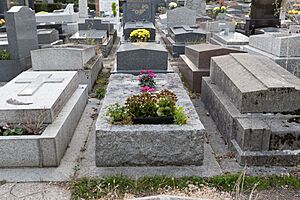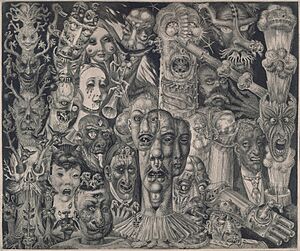Eduard Wiiralt facts for kids
Quick facts for kids
Eduard Wiiralt
|
|
|---|---|
| Eduard Viiralt | |
| Born | 20 March 1898 Tsarskoselsky Uyezd, Saint Petersburg Governorate, Russian Empire
|
| Died | 8 January 1954 (aged 55) Paris, France
|
| Nationality | Estonian |
| Education | Anton Starkopf |
| Alma mater | Pallas Art School Dresden Academy of Art |
Eduard Wiiralt (born March 20, 1898 – died January 8, 1954) was a very famous Estonian artist who specialized in printmaking. He is known as one of the most important Estonian graphic artists from the first half of the 1900s. Some of his most well-known artworks include "Inferno," "Hell," "Cabaret," "Heads of Negroes," "Sleeping Tiger," and "Head of a Camel."
Contents
Life Story of Eduard Wiiralt
Eduard Wiiralt was born in 1898 in a place called Kalitino Manor, near Saint Petersburg in what was then the Russian Empire. His parents, Anton and Sophie-Elisabeth Wiiralt, worked there. In 1909, his family moved to Estonia.
When Eduard was 17, he started studying art at the Tallinn School of Applied Art. One of his teachers was a famous Estonian painter named Nikolai Triik. Triik had a big impact on Eduard's early art. However, Eduard couldn't finish his studies there because of World War I and the Russian Revolution.
Eduard then continued his art education in Tartu, Estonia, at the Pallas art school. He studied sculpture with Anton Starkopf in 1919. At Pallas, he learned about engraving by studying old art masters. This training influenced his art style for many years. His studies were paused again when he joined the Estonian War of Independence.
From 1922 to 1923, Wiiralt studied in Germany at the Dresden Academy of Art. There, he worked with Professor Selmar Werner. You can see some influence of German art styles from that time in his works. Eduard came back to Tartu in 1923. In 1924, he finished his studies in graphic arts at Pallas. He even led the graphic studio there for a year.
In 1925, he moved to Paris, France, and lived there for most of the time until 1938. While in Paris, he created his famous etching called Hell. In 1937, an art show in Vienna gave him a gold medal. They recognized him as the best engraver in Europe! From 1938 to 1939, he lived and worked in Marrakesh, Morocco, before returning to Estonia.
Later Years and Passing
Eduard Wiiralt stayed in Estonia during World War II. In 1944, he tried to go back to Paris, but the war led him to Germany and then to Sweden instead. He finally made it back to Paris in the fall of 1946. He lived in the southern part of the city, in a town called Sceaux.
Eduard Wiiralt passed away in Paris at the age of 55 on January 8, 1954. He was buried in the famous Père Lachaise Cemetery on January 12, 1954.
Famous Artworks
The Etching "Hell"
One of Eduard Wiiralt's most famous works is an etching called Hell, made in 1932. An etching is a type of printmaking where an image is carved into a metal plate using acid. This print is about 39.4 by 46.8 centimeters in size.
The artwork Hell is part of the collection at the Art Museum of Estonia (also known as Eesti Kunstimuuseum). Using old art techniques, this print shows dark feelings like social unfairness and loneliness. It is said to show "the darkest parts and fears of human nature."
Where to See His Art
Eduard Wiiralt's artworks are kept in many art collections in Europe and America. You can find his pieces in museums in Paris, the Albertina museum in Vienna, and the Hamburg Kunsthalle. His art is also in the Cabinet des Estampes in Antwerp, the Berlin Kupfertsichkabinett, and the Prints Division of The New York Public Library.
Other places where his art is displayed include the National Museum in Stockholm, the Calografia Nationale in Rome, and the Museum of Western Art in Moscow.
Eduard Wiiralt created about 450 artworks in total. These include different types of prints like engravings, etchings, wood engravings, and lithographs. He was a member of important art groups in Paris, like the Salon d'Automne and the Salon des Independents. He was also an honorary member of the Royal Society of Etchers and Engravers in London.



